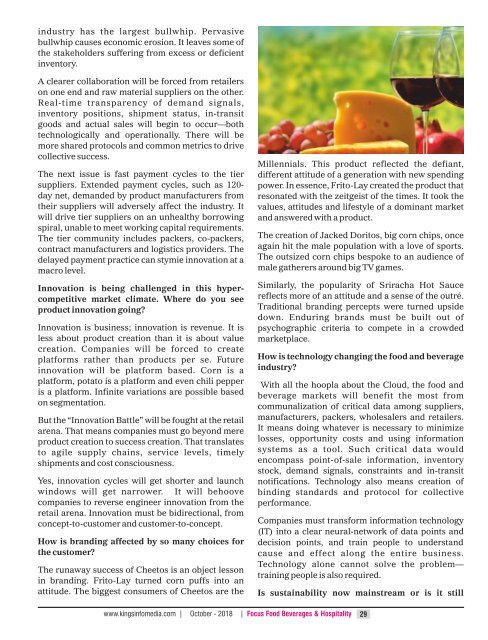Food Beverages And Hospitality October 2018
Create successful ePaper yourself
Turn your PDF publications into a flip-book with our unique Google optimized e-Paper software.
|<br />
|<br />
industry has the largest bullwhip. Pervasive<br />
bullwhip causes economic erosion. It leaves some of<br />
the stakeholders suffering from excess or deficient<br />
inventory.<br />
A clearer collaboration will be forced from retailers<br />
on one end and raw material suppliers on the other.<br />
Real-time transparency of demand signals,<br />
inventory positions, shipment status, in-transit<br />
goods and actual sales will begin to occur—both<br />
technologically and operationally. There will be<br />
more shared protocols and common metrics to drive<br />
collective success.<br />
The next issue is fast payment cycles to the tier<br />
suppliers. Extended payment cycles, such as 120-<br />
day net, demanded by product manufacturers from<br />
their suppliers will adversely affect the industry. It<br />
will drive tier suppliers on an unhealthy borrowing<br />
spiral, unable to meet working capital requirements.<br />
The tier community includes packers, co-packers,<br />
contract manufacturers and logistics providers. The<br />
delayed payment practice can stymie innovation at a<br />
macro level.<br />
Innovation is being challenged in this hypercompetitive<br />
market climate. Where do you see<br />
product innovation going?<br />
Innovation is business; innovation is revenue. It is<br />
less about product creation than it is about value<br />
creation. Companies will be forced to create<br />
platforms rather than products per se. Future<br />
innovation will be platform based. Corn is a<br />
platform, potato is a platform and even chili pepper<br />
is a platform. Infinite variations are possible based<br />
on segmentation.<br />
But the “Innovation Battle” will be fought at the retail<br />
arena. That means companies must go beyond mere<br />
product creation to success creation. That translates<br />
to agile supply chains, service levels, timely<br />
shipments and cost consciousness.<br />
Yes, innovation cycles will get shorter and launch<br />
windows will get narrower. It will behoove<br />
companies to reverse engineer innovation from the<br />
retail arena. Innovation must be bidirectional, from<br />
concept-to-customer and customer-to-concept.<br />
How is branding affected by so many choices for<br />
the customer?<br />
The runaway success of Cheetos is an object lesson<br />
in branding. Frito-Lay turned corn puffs into an<br />
attitude. The biggest consumers of Cheetos are the<br />
Millennials. This product reflected the defiant,<br />
different attitude of a generation with new spending<br />
power. In essence, Frito-Lay created the product that<br />
resonated with the zeitgeist of the times. It took the<br />
values, attitudes and lifestyle of a dominant market<br />
and answered with a product.<br />
The creation of Jacked Doritos, big corn chips, once<br />
again hit the male population with a love of sports.<br />
The outsized corn chips bespoke to an audience of<br />
male gatherers around big TV games.<br />
Similarly, the popularity of Sriracha Hot Sauce<br />
reflects more of an attitude and a sense of the outré.<br />
Traditional branding percepts were turned upside<br />
down. Enduring brands must be built out of<br />
psychographic criteria to compete in a crowded<br />
marketplace.<br />
How is technology changing the food and beverage<br />
industry?<br />
With all the hoopla about the Cloud, the food and<br />
beverage markets will benefit the most from<br />
communalization of critical data among suppliers,<br />
manufacturers, packers, wholesalers and retailers.<br />
It means doing whatever is necessary to minimize<br />
losses, opportunity costs and using information<br />
systems as a tool. Such critical data would<br />
encompass point-of-sale information, inventory<br />
stock, demand signals, constraints and in-transit<br />
notifications. Technology also means creation of<br />
binding standards and protocol for collective<br />
performance.<br />
Companies must transform information technology<br />
(IT) into a clear neural-network of data points and<br />
decision points, and train people to understand<br />
cause and effect along the entire business.<br />
Technology alone cannot solve the problem—<br />
training people is also required.<br />
Is sustainability now mainstream or is it still<br />
www.kingsinfomedia.com<br />
<strong>October</strong> - <strong>2018</strong><br />
Focus <strong>Food</strong> <strong>Beverages</strong> & <strong>Hospitality</strong><br />
29

















